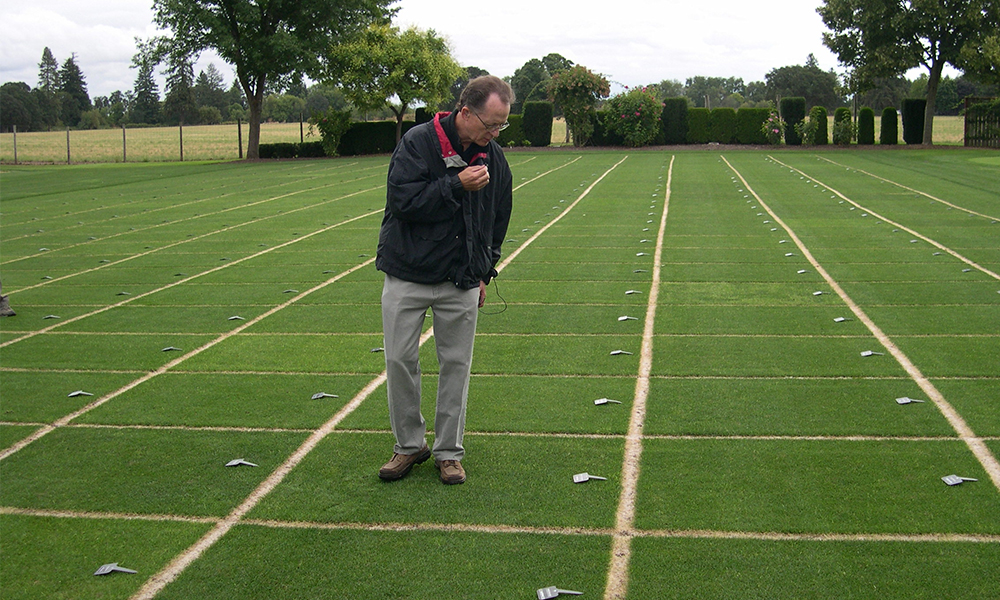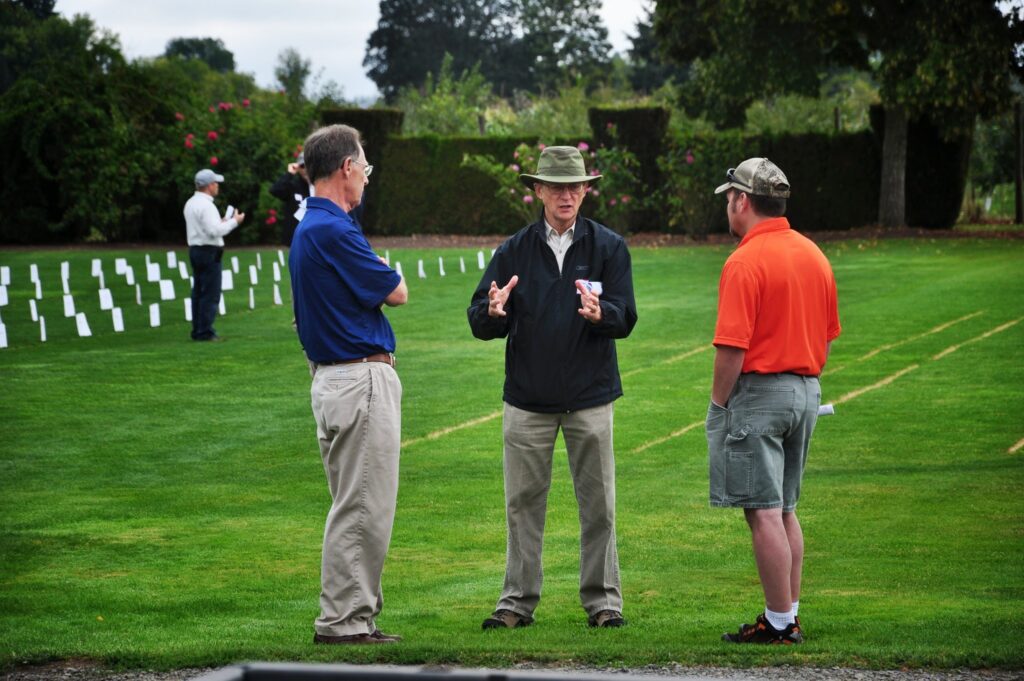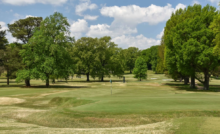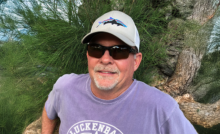Q&A with the Legendary Turf Professor, Tom Cook – Part 2: Making the Rounds – Installment 36


Tom Cook one last plot inspection at the Farm in 2008
This column features recollections of the author’s 37 years as a golf writer. These installments stem from his many travels and experiences, which led to a gradual understanding that the game has many intriguing components, especially its people.
Dave Phipps, the GCSAA’s Northwest Regional representative, attended Oregon State and was taught by Tom Cook. The university in Corvallis now offers the only major turf program on the West Coast but, according to Phipps, its future is tenuous. “Currently, there is only one position endowed in the program and the rest are funded from ‘soft’ money,” he said. “We are currently about halfway through a campaign to raise $1 million for a second turfgrass professor.”
Phipps is thankful for his time with Cook. “Tom is just a first-class individual; we are all proud to have been under his influence. He always had a no-nonsense approach to turfgrass management. That’s probably what drew me to the program in the first place. As an incoming transfer from Portland Community College, I was engaged right away by Tom’s teaching. Admittedly, I wasn’t his star student by any means but that didn’t make a difference. He allowed me to explore all parts of the industry through my internship and senior project. He always had faith in me and whatever direction I went after school.


“I was not your typical ‘got-to-be-a-superintendent’ turfgrass student. I explored all aspects of the turf industry, including grass seed and turf equipment sales, and even landscape management. The whole time Tom stood behind me and watched my progress. I know he had doubts about all the directions I was going. But I had built Stone Creek Golf Club in Oregon City and then moved on to work for the GCSAA. That’s when he told me how proud he was of the career I had assembled and considered me one of his ‘star’ students. That compliment means the world to me.”
Phipps is just one of many students Tom Cook prepared for the golf and turf industries. Listed further down is only a partial list of the hundreds of graduates he shepherded through his program and the rich careers they went on to enjoy. Like in Part 1 of this Q&A, interspersed are testimonials from some of Cook’s former students.
Here’s Part 2 of my Q&A with Cook.
Jeff Shelley: Have you always enjoyed teaching? Feel free to explain. How about an estimate of the number of turf students you’ve taught?
Tom Cook: “Teaching can be very enjoyable. It can also be a terrifying experience. When I started, I was mostly terrified. I would wake up at night drenched with sweat and worrying about what I was going to do in class tomorrow. Fortunately, teaching is a bit like the movie ‘Ground Hogs Day.’ Each year the clock resets with a new batch of students. I could build on the things that worked last year and improve the things that didn’t. With time, I could get the format worked out and update information and assignments as needed. At that point teaching became fun.
“Ultimately, for me it was an opportunity to observe and study my students to learn about their habits, character, strengths and weaknesses. These observations then helped me guide them to jobs and people who would be the kind of mentors they needed. Some students are very accomplished, self-confident, and mature, while others are scared, lack confidence, and need to be nurtured. With the right opportunities, both can succeed. I was never looking for potential graduate students; I just wanted to help students develop confidence and move forward to contribute to the field. Almost all my students were good people with lots of potential. They weren’t always great students academically, but they all had something to offer if they could find the right path.
———————————————————————————————-
“Tom felt more like a foster big brother than my professor. He asked me what I wanted to do in this industry, then paved the way. He has so many good relationships that provide opportunities for his students – a lesson in its own.” – Bill Webster, retired Superintendent, Seattle GC & Pumpkin Ridge
———————————————————————————————-
“I recently tallied up all the students I had in my classes who ended up in the industry after graduating. By my count, just over 350 students left school and began careers in the turf and landscape industry. Close to 200 started in the golf industry and the rest worked in lawncare, commercial landscape construction and maintenance, park maintenance, spray services, etc. There is a lot of movement in this business – and many have moved on from being golf course superintendents to selling turf-care products or into sports-turf management. I am surprised by how many have stayed in some facet of the industry.”
JS: Please note any personal info you care to divulge.
TC: “As [my wife] Marilyn can attest, I spent far too much time working. During the week I generally went to the office early, came home for dinner and then went back to the office until 10 p.m. Saturday was a free day, but Sunday from noon on I was back at work. In summer I was on the road or at the research farm. I could do it all when young, but by the time I was 58, I ran out of gas. So, I retired in 2008 and got reacquainted with my life.
“I’m still passionate about lawns and have my own private collection of grasses from around the state. My golf game has improved thanks to Brian McDonald, who is a friend, coworker, and very good golf coach. I try to play once a week at Trysting Tree [home course of the OSU Beavers’ golf teams] with a group of friends and spend a lot of time rationalizing about how I could have had a good score except for this, that, or the other thing.”
———————————————————————————————-
“I graduated in 1979 along with Andy Soden, Tom Christie and John Ford. I’m pretty sure it was the first class to graduate under Tom in the Turf Management program. [Author’s Note: it was.]
“When I met Tom, I was working across the street from Cordley Hall in the School of Oceanography. I had just enrolled in the Ornamental Production program and heard about the new Turf Management program. It took all of two minutes for me to sign on after our first talk.
“Tom’s easy manner and spirit made the process fun and challenging. In his first lecture he said: ‘For those of you interested in becoming a golf course superintendent, you’ll need two things: common sense and drainage. In the absence of common sense, add more drainage.’ To this day I still have fun with that lesson. We’ve shortened it up to – ‘You need more drainage.’
“Tom was a huge basher of Scott’s products and in love with ammonium sulfate. I’m reasonably certain that most of his students found a way to very carefully work it into their programs. Tom was a fan of Dr. Roy Goss, who considered sulfur to be the fourth major element. Tom also advocated for its use in fine turf management. I think Tom was ahead of the pack with this element.” – Tom Flaherty, retired Superintendent, Woods Hole & Oysters Harbor GCs
———————————————————————————————-
JS: List any or all your major accomplishments, personal or otherwise.
TC: “Personally, I married Marilyn, the love of my life. We have a son Bryan and daughter-in-law Laren who I admire and enjoy spending time with. I became part of Marilyn’s wonderful family and look forward to visiting them whenever possible.
“Professionally, I spent 31 years developing a teaching program in turf and landscape management. I built – with the help of many, many students – a field lab where they could experiment and learn by working with other students. I liked to tell them it was okay to kill my grass so they could avoid that problem once out in the real world.
“At our peak, we had a well-oiled machine cranking out students who attained great success and helped change the industry in a good way. Through my connections in the industry, I could assist students in finding work with top superintendents who would help them learn.
“As a capstone, I coauthored a book titled ‘Sustainable Landscape Management’ with my friend and colleague, Ann Marie VanDerZanden. It wasn’t the turf book I had hoped to write, but it’s an important subject and was a nice way to finish my time at OSU.
“I have my share of plaques and awards. But being part of the journey and watching former students succeed, at levels I could never have done myself, is an amazing experience.”
JS: Speaking of . . . list and provide brief bios of some of the many superintendents you taught and have followed their careers.
TC: Early students:
Tom Christy started on the crew at Eugene Country Club then went to Almadin CC in California back to the Pacific Northwest at Riverside G&CC and then to Sand Point CC. He then worked with OB Sports and ended his career in Las Vegas.
John Ford started at Oswego Lake CC, then Royal Oaks CC, then Tacoma C&GC, and finally at Fort Lewis GC.
Tom Flaherty spent most of his career at Woods Hole GC in Massachusetts.
———————————————————————————————-
“Tom Cook is one of the most amazing individuals I have ever met in my life. He has the ‘it’ factor. He’s smart, humble, classy, professional, thorough, caring …
“He wanted you to learn. I remember him saying once in class that he didn’t give ‘gotcha tests.’ But you were going to learn the basics of turf management no matter how many times you may have to retake a test. He’s as genuine as they come and guided me successfully through my one year at OSU, which involved taking every course he taught. I still ask him questions every so often and thoroughly enjoy discussing the turfgrass business with him. He is a legend and an icon. I have only met one other person in my life who I put on the highest pedestal with him. He is an amazing human being along with the greatest of all time when it comes to turf science and practicality.” – Dave Gaughan, retired, Eugene Country Club
———————————————————————————————-
TC: Portland metro:
Brian Koffler is at Waverley and formerly at the Olympic Club’s Lake course in San Francisco.
Gordon Kiyokawa is at Royal Oaks in Vancouver, Wash., and formerly at Columbia Edgewater in Portland, Semiahmoo in Washington and built the Indian Creek GC in Hood River.
Nolan Wenker is at Oswego Lake CC and was at Langdon Farms.
Alexis Wenker is the executive director of the OGCSA and was an assistant superintendent at Oswego Lake CC.
Russell Vandehey is at Oregon Golf Club after the Resort at the Mountain. He and his brother Roger built Florence Golf Links.
Eric Feldhusen is at Pumpkin Ridge.
Mike Turley is at Stone Creek in Oregon City.
Bob Senseman, who is now retired. was superintendent at Resort at the Mountain, Columbia Edgewater CC, then worked as a USGA Green Section rep before returning to Oswego Lake CC to finish his career.
Bill Webster, also retired, came to us from La Grande, Ore. He became the superintendent at Seattle Golf Club and left there to build Pumpkin Ridge near Portland. After many years there, he worked for several years at Pacific Sports Turf.
Dave Phipps was construction superintendent at Stone Creek and managed the golf course for many years. He was instrumental in developing environmental guidelines for golf courses and now works for the GCSAA as a regional representative.
TC: Seattle area:
Mike Conklin is at Everett CC. Previously Mike was the construction superintendent at Trilogy at Redmond Ridge near Woodinville and before that he built Persimmon GC in Gresham.
Sean McDonough is director of agronomy at Broadmoor.
Blaine Hezel is at Useless Bay and previously was superintendent at Pt. Roberts.
Joel Kachmarek is the long-time superintendent at Tacoma C&GC.
Ryan Gordon is superintendent at the Golf Club at Snoqualmie Ridge. He was a protégé of Paul Colleran at Aldarra Golf Club east of Seattle.
Eric Johnson is the director of agronomy at Chambers Bay near Tacoma. He previously was superintendent at Bandon Dunes and, before that, Spyglass Hill at Pebble Beach.
Jay Griswold is the longtime superintendent at RMG Club at Oakbrook in Lakewood.
TC: Oregon Coast:
John Whisler was one of my few graduate students finishing at OSU with an MS degree. He was superintendent at Springfield CC before moving to Astoria G&CC where he spent the rest of his career before recently retiring.
Forrest Goodling started at Corvallis CC, moved to Charbonneau, was at Portland GC for many years, and now is having the time of his life at Gearhart Golf Links.
Ken Nice is the property manager at Bandon Dunes Golf Resort and built several of the golf courses on the property. One of Ken’s superintendents is Marcus Lakey, who has spent his entire career at Bandon Dunes.
Troy Russell built the original Bandon Dunes course and Bandon Trails. He was the construction superintendent at Wine Valley in Walla Walla, Wash., and continues building new projects throughout the Northwest.
TC: Central Oregon:
We have had many people work at courses in Central Oregon over the years. Paul Rozek is the long-time superintendent at Widgi Creek near Mt. Bachelor. Scott Moffenbier is superintendent at Bend CC; before that he was at Broken Top. David Freitag is director of agronomy at Pronghorn, and Ryan Wolf is superintendent at Sunriver.
TC: Other Notable Graduates:
Brian McDonald was an accountant who decided to change directions and study turf. He was an outstanding student, a wizard with computers and spreadsheets and had a talent for doing research. He worked at Waverley CC for his internship and was the first person I was able to hire full time to work at the research farm. Over the years he has become the backbone of our research efforts. He conducts most of the spray trials, manages the research area, teaches, does extension work and continues to help me improve my golf swing.
Tom Huesgen is currently working as superintendent at Ranch Santa Fe in California. Tom was superintendent at Pebble Beach GC, built the course at Telluride in Colorado, remodeled Poppy Hills, and was superintendent at Sahalee Country Club in the Seattle area.
Stan Kazymerchyk was superintendent at Vancouver Golf Club in Canada. He later moved to Kwantlen Polytechnic University, where he ran the turf and landscape program for many years.
Micah Woods worked as a superintendent in China and Japan, went on to a PhD at Cornell University and started his own golf course research and consulting business, “Asian Turfgrass Center,” which operates out of Thailand and serves tropical turfgrass facilities worldwide.
Cory Isom was a golf superintendent in Hawaii and is the current USGA green section rep for the Pacific Northwest and Hawaii.
———————————————————————————————-
“I can certainly attribute most of my career successes to Tom. In my formidable years at Oregon State, as a lost student looking for some career guidance, Tom’s intelligent and soft demeanor provided the perfect balance of tutelage to guide me in the right direction. One of my first meetings with him was during a pruning class when I was considering a career in Ag. Tom’s humor and kindness allowed for an easy, trusting relationship to develop and at the time, Tom suggested Golf Course Maintenance as a possible choice, stating that ‘it’s a lot like farming – just in the city’ So, I jumped in head-first.
“Over the course of my nearly 35 years as a superintendent, Tom assisted me in every aspect of GC maintenance and, perhaps more importantly, how to deal with people and committees. Tom frequently provided site visits to present his valuable opinion on different matters to Green Committees and members, often smoothing out their concerns. I am forever indebted to Tom for his advice and support.” – Gordon Kiyokawa, Superintendent at Royal Oaks CC; formerly at Columbia Edgewater CC & Semiahmoo G&CC
———————————————————————————————-
Scott Larsen, currently the superintendent at Emerald Valley in Creswell Ore., worked in golf course construction in California and the Pacific Northwest for many years. He has donated time and expertise in constructing putting greens at our 5-acre research farm and always allowed us to conduct research trials on his course.
Chris Gaughan was at Eugene Country Club for many years dating back to Tom Christy’s time in the late 1970s. He spent a year in our program as he prepared for the superintendent’s job at Eugene. He retired recently after a long and impressive career.
Eugene’s current superintendent is Phil Lago. He was superintendent at Wild Horse in Central Oregon and Black Butte Ranch prior to coming to Eugene.
TC: Notable graduates in related industries:
Bob Grover is co-owner and manager at Pacific Landscape Management. It operates throughout the Willamette Valley, the Portland/Vancouver metro area, and now in greater Seattle. Bob has worked his entire life in the landscape and nursery business. He recently created an endowed teaching position at Oregon State in Ornamental Horticulture and has always been one of our strongest supporters.
Dick Fluter, a former superintendent at Oswego Lake CC, started Pacific Sports Turf, which is an industry leader throughout western Oregon and Washington.
Sue Nicol developed the plan for landscape management of exhibits at the Woodland Park Zoo in Seattle. She then founded her own consulting arborist business from which she recently retired.
We have many more former students working throughout the West – from the Canadian border to Southern California. I wish I could list them all!
JS: Please list any awards/citations you’ve received.
TC: Teaching:
R.M. Wade Award for Excellence in Teaching, OSU College of Ag.
“Who’s Who Among America’s Teachers”
Industry:
OGCSA Distinguished Service Award 2006
OGCSA Hall of Fame 2010
GCSAA Distinguished Service Award 2006
JS: What are you most proud of?
TC: My students and the contributions they’ve made to the industry.
JS: As a very well-informed veteran of the golf industry, what challenges do you foresee for the folks maintaining courses?
TC:
“One: Labor, labor, labor. It has always been challenging to find quality people to work on golf courses. Many courses rely on immigrant labor because they work hard, are reliable, and do good work. The current anti-immigration mood in the U.S. will certainly reduce undocumented people and may also impact those who are here legally. Time will tell. My friends in the business often remark that it is difficult to find young white men who can pass drug tests and show up regularly in a fit state to work. We can expect to see more robotic mowing as technology improves and labor issues get worse.
“Two: Weed, disease, and insect problems have changed over the years. Many pests common today were not problems when I started in the 1970s. Loss of pesticides due to environmental concerns about current chemicals will make pest control more challenging.
“Three: Bunkers have become the most expensive area to maintain on golf courses. Newer bunker designs often require a great deal of hand labor, and it is tedious to hand mow the edges regularly. Bunker duty almost seems like punishment.
“Four: Equipment costs have skyrocketed in recent years as machines have become more sophisticated. This is already posing problems for lower-budget golf courses.
“Five: At public courses, balancing play and revenue against maintenance needs has always been a problem, particularly regarding greens’ maintenance practices such as coring and topdressing. Increased reliance on cart rentals increases wear and turf damage on fairways and green surrounds, adding to maintenance costs.
“Six: Water availability and quality are issues for many courses and that will only increase as more new courses are constructed.
“All the above issues have been with us for a long time, but they all make life difficult for the maintenance staff and will get worse as we move forward.”
I found it refreshing to reconnect with Tom Cook after all these years. It’s almost guaranteed that his legions of former students will continue carrying on and spreading his wisdom and teachings for years to come.
Jeff Shelley has written and published 10 books as well as numerous articles for print and online media since 1987. Among his titles are three editions of the book, “Golf Courses of the Pacific Northwest.” The Whidbey Island resident was editorial director of Cybergolf.com from 2000-15, co-founder of the Northwest Golf Media Association and president of the nonprofit First Green (https://www.thefirstgreen.org/). To contact Jeff: fairgreens@seanet.com.
Recent Posts
Memphis Country Club: A Golfer’s Study in Precision and Tradition
If you have ever teed it up at Memphis Country Club, you know this isn’t…
Foley Company attains GCSAA Silver Partner Status
Foley Company, a leader in turf equipment innovation and technology, affirms its support of the…
Harrell’s continues longstanding support of the GCSAA Foundation
Harrell’s LLC, a leading distributor of customized agronomic products for turfgrass since 1941, has donated…
City of Orlando Announces New State-of-the-Art Driving Range at Dubsdread Golf Course
The City of Orlando is excited to announce the construction of a brand-new, state-of-the-art driving…
Discover Puerto Rico for Great Golf Trips and After-Round Activities, Amenities
Golfers cannot live by the game alone which is why Puerto Rico provides the perfect…
Q&A with a Multi-talented Golf Course Architect – Part 2: Making the Rounds – Installment 39
This column features recollections of the author’s 37 years as a golf writer. These installments…


